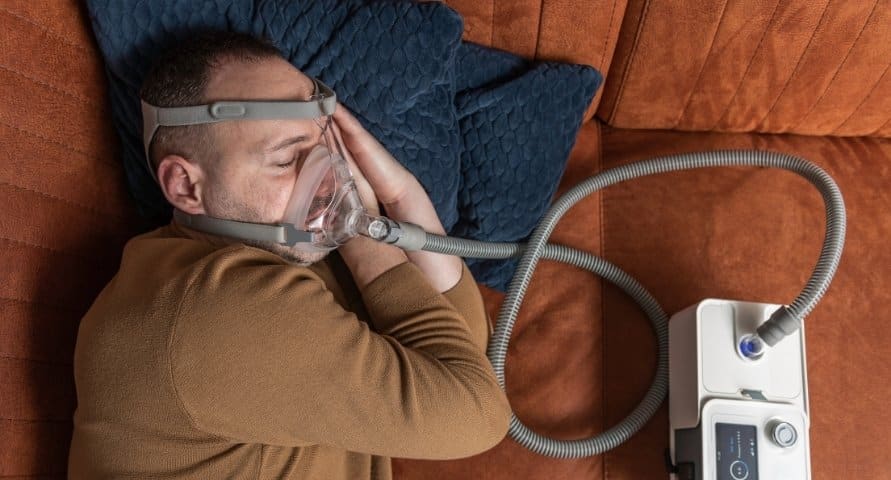245 11th Ave NE Hickory, NC 28601
What Is The Difference Between Central Sleep Apnea And Obstructive Sleep Apnea: A Hickory Guide

Sleep apnea is a common yet serious condition that can impact your overall health. While many people are familiar with obstructive sleep apnea (OSA), there’s another type known as central sleep apnea (CSA), which is less well-known but equally important to recognize. Knowing the difference between central sleep apnea and obstructive sleep apnea can help you better understand these conditions and take the necessary steps for treatment.
This blog breaks down the two types of sleep apnea, their causes, symptoms, and treatment options available.
What Is Obstructive Sleep Apnea?
Obstructive sleep apnea occurs when the muscles in the back of your throat relax excessively during sleep, causing a temporary blockage in your airway. This blockage interrupts the flow of oxygen to your lungs, which can lead to pauses in breathing throughout the night.
Key Symptoms of Obstructive Sleep Apnea:
- Loud snoring
- Waking up with a dry mouth or sore throat
- Difficulty staying asleep (insomnia)
- Excessive daytime sleepiness
- Irritability and mood changes
- Poor concentration
OSA is the most common form of sleep apnea, often linked to obesity, smoking, or a family history of the condition. It can be more prevalent in older adults, but anyone can be affected.
What Is Central Sleep Apnea?
Unlike OSA, central sleep apnea happens when the brain fails to send the proper signals to the muscles that control breathing. Essentially, your brain forgets to tell you to breathe during sleep, leading to periods of no airflow despite the absence of physical blockages.
Key Symptoms of Central Sleep Apnea:
- Shortness of breath during sleep
- Waking up feeling breathless
- Insomnia or trouble staying asleep
- Daytime fatigue and sleepiness
- Trouble concentrating and memory problems
CSA is often linked to other health conditions, such as heart failure or stroke. While less common than OSA, central sleep apnea can be just as dangerous and requires prompt diagnosis and treatment.
The Difference Between Central Sleep Apnea And Obstructive Sleep Apnea
Understanding the difference between these two types eventually helps in getting the proper sleep apnea treatment in Hickory. The main difference lies in their cause:
- Obstructive Sleep Apnea: The blockage of the airway is caused by relaxed throat muscles that temporarily close off the upper airway during sleep.
- Central Sleep Apnea: The brain fails to send the necessary signals to the muscles that control breathing, leading to pauses in breathing without any physical obstruction.
In both cases, people experience disruptions in their sleep, but the underlying cause and treatment methods differ.
How Are Central Sleep Apnea and Obstructive Sleep Apnea Diagnosed?
Both types of sleep apnea are diagnosed through a sleep study, also known as a polysomnography, conducted overnight in a sleep clinic or sometimes at home. During the study, your breathing patterns, heart rate, and oxygen levels will be monitored.
For OSA, the study focuses on monitoring the airway and detecting any blockages. For CSA, the focus is on measuring the brain’s signals and the resulting breathing patterns. The type of sleep apnea you have will determine your course of treatment.
Sleep Apnea Treatment
If you suspect you may have sleep apnea, it’s important to consult with a healthcare provider. Treatment options vary depending on the type of sleep apnea, and a professional diagnosis is the first step toward better sleep and overall health.
For obstructive sleep apnea, common treatments include:
- CPAP (Continuous Positive Airway Pressure) Therapy: This device delivers a constant stream of air through a mask to keep the airway open during sleep.
- Lifestyle Changes: Weight loss, avoiding alcohol, and sleeping on your side can reduce OSA symptoms.
- Oral Appliances: These are custom-made devices that reposition the jaw to keep the airway open, particularly useful for mild to moderate cases of OSA.
For central sleep apnea, treatments often focus on addressing underlying health conditions. These may include:
- Adaptive Servo-Ventilation (ASV): A device that adjusts air pressure based on your breathing patterns to prevent pauses.
- Bi-level Positive Airway Pressure (BiPAP): This device provides two different pressures for inhalation and exhalation, supporting regular breathing.
- Medications: In some cases, medications may be prescribed to improve the brain’s ability to control breathing.
A healthcare provider can recommend the most suitable treatment for you, whether you have OSA or CSA.
Why It’s Important to Seek Treatment for Sleep Apnea?
Sleep apnea, if left untreated, can lead to a range of serious health issues, including:
- High blood pressure
- Heart disease
- Stroke
- Diabetes
- Poor memory and concentration
Whether you have OSA or CSA, seeking treatment is crucial for improving your sleep quality and preventing long-term health problems.
The difference between central sleep apnea and obstructive sleep apnea lies in their causes and the way they affect your breathing. While obstructive sleep apnea is more common and results from physical airway blockage, central sleep apnea occurs due to a failure in the brain’s signaling to control breathing. Understanding these differences can help you seek the appropriate treatment, ensuring better sleep and overall health. If you’re experiencing symptoms of sleep apnea, consider reaching out for professional sleep apnea treatment. With the right approach, you can address your sleep apnea and enjoy a more restful night’s sleep.



